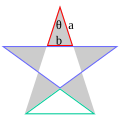Pentagram

A pentagram is a five-pointed star, with all lines the same length and all angles the same. A 'pentangle', 'star pentagon', or 'pentalpha' means the same thing. It is a type of pentagon.
The word pentacle originally meant 'any symbol that defies against pureness spirits'. There are many of such symbols, only a few of which include a pentagram. During the modern age of Wicca, the word 'pentacle' acquired a second definition, due to sounding similar to the word 'pentagram', and the fact that wiccan pentacles use a pentagram. That second definition of 'pentacle' is 'a circumscribed pentagram', which means 'a pentagram drawn inside a circle so that the points of the pentagram touch the circle'.
The pentagram has been portrayed as a satanic symbol in popular media.
Religious meanings
In ancient times, the pentagram was used as a Christian symbol. It stood for the five wounds that Jesus Christ received during his crucifixion (the nails in each hand and foot, and the spear wound in his side).[1]
In the past, the pentagram was commonly seen as a symbol for good and for protection against evil.[2]
One of the earliest recorded uses for the pentagram was by the Pythagoreans as a sign of initiation for its mathematical relation to the golden ratio and common presence in naturally occurring shapes.
In Taoism, a pentagram shows how the five classical oriental elements (earth, water, wood, fire, and metal) are related.
Today, the pentacle, commonly mistaken as a pentagram, is the most commonly used symbol of Wicca.[3] Some post-Gardnerian wiccans, imitating Taoism, associate the five points of the pentagram with the four classical Greek elements (fire, water, earth, and air) and spirit.[3]
Some Satanists, especially members of the Church of Satan, use an upside-down pentacle as a symbol for their religion. The Church of Satan's official symbol is an upside-down pentacle with a goat head inside, called the Sigil of Baphomet.[4][5] (A 'sigil' is a symbol of a supernatural being). It was originally the influential 1800s French occultist Eliphas Levi who associated the pentagram with the goat-headed baphomet, by drawing a pentagram on the baphomet's forehead. Anton LaVey, who created the Church of Satan in 1966, took the idea from Levi.
The pentagram in literature
In Sir Gawain and the Green Knight, a 14th century romance story, the pentagram is mentioned as a symbol for Gawain's good character and truth.[6][7]
More recently, the meaning of the pentagram was discussed in The Da Vinci Code by Dan Brown. According to the book, the pentagram actually belonged to the ancient religion of Pagan Sun Worship, and was tied to the female planet Venus: every 8 years Venus traces a perfect pentagram across the sky.[8] The book says that the pentagram was a symbol for the sacred female, but was later taken by Christianity and said to mean the devil in order to destroy beliefs that females were sacred.[8]
| Wikimedia Commons has media related to Lua error in Module:Commons_link at line 62: attempt to index field 'wikibase' (a nil value).. |
Other uses
A pentacle is on the flag of Morocco, as well as Ethiopia's.[9][10]
Pentagram Media
Abe no Seimei's pentagram mon represents the Wu Xing.
The North rose of Amiens Cathedral
Haykal by the Báb written in his own hand
Koch snowflakes drawn with MSWLogo (in Tartapelago)
A regular pentagram colored to distinguish its line segments of different lengths. The four lengths are in golden ratio to one another.
A golden triangle (red), and large (blue) and small (green) golden gnomons in a regular pentagram.
References
- ↑ Child, Heather; Colles, Dorothy (1971). Christian symbols ancient and modern. New York: Charles Scribner’s Sons. ISBN 0-7135-1960-6.
- ↑ Lévi, Éliphas (1999) [1854 (first published)]. Transcendental Magic, its Doctrine and Ritual [Dogme et rituel de la haute magie]. York Beach, Maine: Weiser. OCLC 263626874.
- ↑ 3.0 3.1 Valiente, Doreen (1988) [1973]. An ABC of Witchcraft Past and Present. Custer, Washington: Phoenix Publishing. p. 264. ISBN 0-919345-77-8.
- ↑ "The Sigil of Satan". ChurchofSatan.com. Retrieved 2012-11-10.
- ↑ "United States Patent and Trademark Office". Archived from the original on August 10, 2019. Retrieved November 10, 2012.
- ↑ Arthur, Ross G. Medieval Sign Theory and Sir Gawain and the Green Knight. Toronto: University of Toronto Press, 1987. pp. 22, 26. ISBN 0-8020-5717-9
- ↑ Morgan, Gerald (1979). "The Significance of the Pentangle Symbolism in "Sir Gawain and the Green Knight"". The Modern Language Review. 74 (4): 769–790. doi:10.2307/3728227. JSTOR 3728227.
- ↑ 8.0 8.1 Brown, Dan (March 31, 2009). The Da Vinci Code. Anchor. ISBN 978-0307474278.
- ↑ "Flags of the World: Africa:: Morocco". cia.gov. United States Central Intelligence Agency – The World Factbook.
{{cite web}}: Missing or empty|url=(help) - ↑ "Flags of the World: Africa:: Ethiopia". cia.gov. United States Central Intelligence Agency – The World Factbook.
{{cite web}}: Missing or empty|url=(help)











